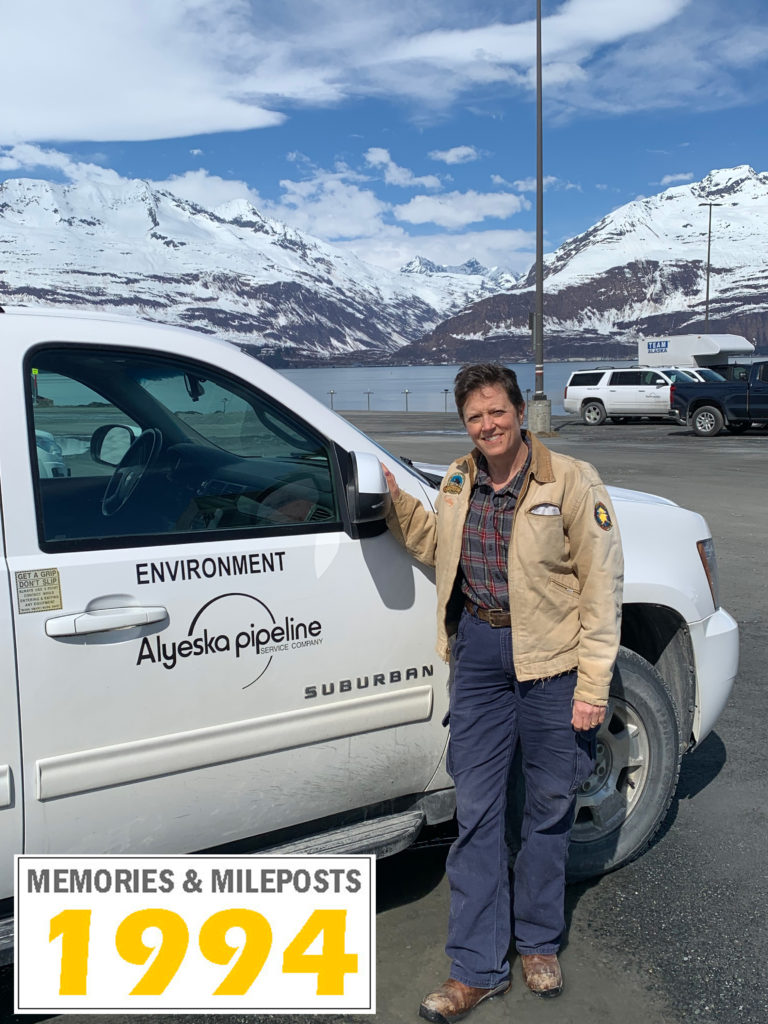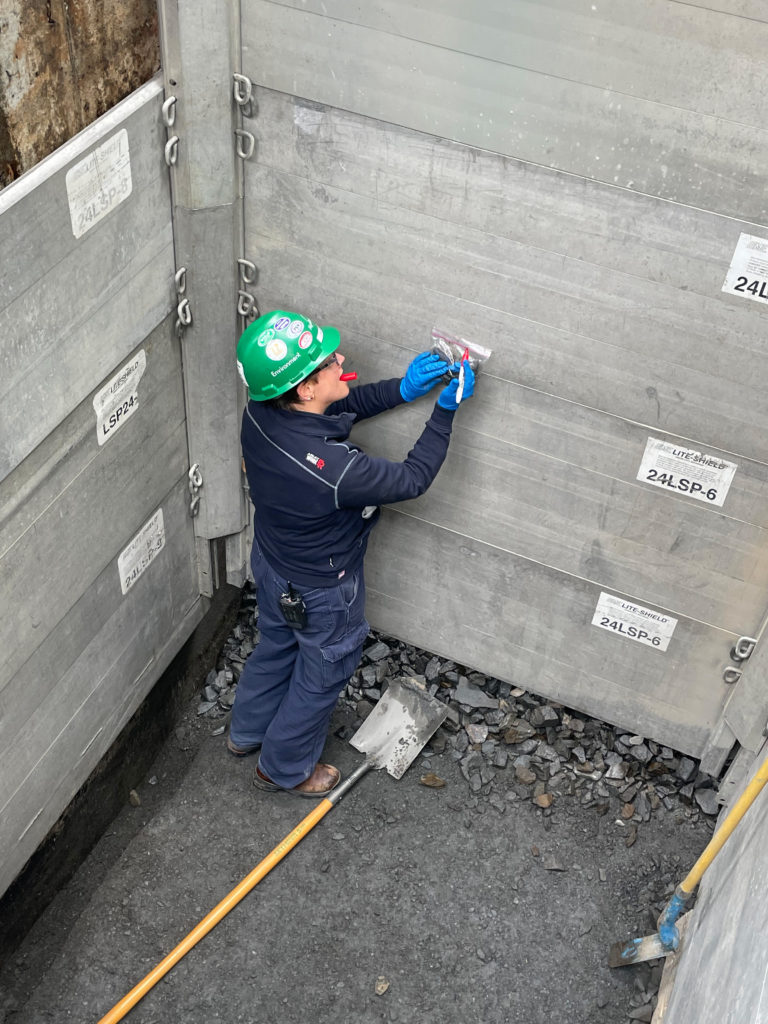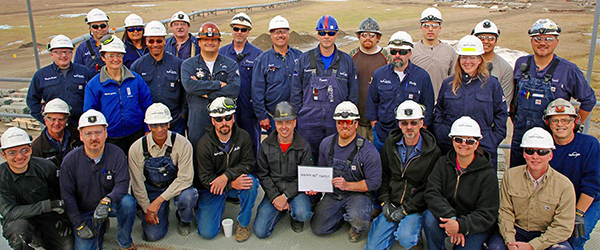Cathy Girard – Environmental Coordinator Supervisor
“We care deeply about the environment, about doing good work, about being credible and competent and about supporting all teams working on TAPS. If you succeed, we all succeed – it’s really that simple.”

Cathy Girard first worked around the Trans Alaska Pipeline System as a regulator in the early 1990s, and before long, her perspective on how to best impact TAPS shifted.
“Over time, my attitude towards the oil industry shifted, and a little voice inside said, ‘Maybe I could be more influential working for the oil industry than against them,’” Cathy recalled. “I realized that maybe I could be a positive influence and not just watch from outside.”
She was fairly fresh out of college, optimistic, young in her career with the Joint Pipeline Office, and the more exposure she had to Alyeska Pipeline and its people, the more she saw a place where she could do good work.
“Every profession has a personality, and in general, people in the environment field do have a bit of a ‘save the world’ kind of bend to us,” Cathy said. “When I got out of college, I assumed I was going to be a broke environmental activist who worked at an NGO or advocacy group. When I started working with Alyeska as a regulator, I started to see, ‘You know, the oil industry actually puts a lot of money and commitment toward what they say they do.’ I started to respect them.”
So Cathy left her position with the JPO to work for Alyeska as an Environmental Coordinator. The year: 1994. Now approaching 30 years with a team known for its dedicated professionals, Cathy serves as an Environmental Coordinator Supervisor.
A lot has changed since 1994 – and a lot hasn’t. New tools like drones have aided and enhanced some environment work, digital cameras replaced canisters of film long ago, and cloud-based technology has eliminated beefy binders of printed materials. But bedrock commitments to environmental protection remain foundational. With her experience and perspective, Cathy sat down with Alyeska’s Corp Comm group to talk about her career, her team, and what makes Alyeska’s environment program special.
Q: What were your first impressions of Alyeska and TAPS when you came to Alaska?
A: As a regulator for the Fairbanks North Star Borough and then for the Alaska Department of Environmental Conservation in the JPO, I saw how the producers and Alyeska had cleaner gravel pads than most grocery store parking lots or my neighbors’ backyards. In particular, I observed Alyeska from a close distance and eventually became convinced that I wanted to be a part of their team. It was the best decision I could have made and I’ve never questioned or regretted it.
Q: In what ways has your approach to your work changed over the years?
A: Being younger and coming from a regulatory background, I was pretty black-and-white in my thinking early on. I’ve softened and matured through seat time to understand when interpretations can be made versus when the letter of the law must be followed. I used to give more edicts. Now I offer options and recommend what I think would best serve our clients and Alyeska. I’ve learned that being resourceful and building relationships is equally important. Working within a team, no matter what the team is, is the key to the success of every one of us.
Q: Speaking of teams, the Environment Team gives the impression of having a tight bond and a shared commitment to work. What motivates you and your coworkers?
A: We care deeply about the environment, about doing good work, about being credible and competent and about supporting all teams working on TAPS. It doesn’t matter if you’re Alyeska or a contractor. If you succeed, we all succeed – it’s really that simple. We aren’t “environmentalists” as we are often referred to. We are educated and experienced environmental professionals who have a passion around environmental stewardship on and off the job.
Q: How would you describe the Environment Team’s working philosophy?
A: During my interview, I was told by the Environment Team Manager, Jim Sweeney, that I didn’t really work for Environment – I worked for everyone but Environment, and that if I couldn’t live by that philosophy then we didn’t need to proceed with the interview. I have tried to instill that foundational principle in my fellow Environmental Coordinators as they joined our team, and definitely as a supervisor. We focus on the environmental component, but we shouldn’t be in a silo of environment. This is not an environmental company, this is a pipeline transportation company. Moving oil is what we do. We’re here to support that mission. Your role in and of itself does not make oil flow. You are a component in making oil flow.
Q: What other values or methods influence your approach to work?
A: Job security doesn’t come from hoarding knowledge. Helping our clients to own their compliance and be self-sufficient is far better for them, for the Environment Team, and for Alyeska as a whole. It is always better to drive environmental ownership and processes into the day-to-day business so that compliance can be seamless and you don’t have to search for a manual or call someone – that’s an impediment to progress. The Safety Team isn’t solely responsible for personnel safety, the Inspections Team isn’t solely responsible for making sure our work passes spec, and it’s no different with Environment. Empowering compliant and wise environmental management through training, clear guidance documents and access to each member of the Environment Team is our model for driving environmental performance and ownership at every level of the company.

Q: When you started in 1994, how was the Environment Team’s work different than now?
A: When I started, we took all of our 110 or 35mm film to town to be developed during our R&Rs. We practically had to take a class to learn to operate our first digital cameras, complete with floppy disks. Now photos are taken with our phones. “Email” was sent via PROFS and your eyes hurt because the monitor displayed in orange type on a black screen from a huge desktop monitor. Now we can work from anywhere at any time. We read and filed hardcopy memos, updated hardcopy binders with routine updates, and carried binders full of manuals and guidance documents in the back seat of our red trucks. Your connection to family and friends was over a landline in your PLQ room. Even after Wi-Fi, it was many years until PLQs got morale lines and they were not as open as they are now. When you left for work you truly left – there was almost no connection to your personal life.
Q: How has new technology or other innovations changed your work?
A: Drones are a new tool in our toolbox for how we can survey an area to look for wildlife during a spill event. We tested a drone surveillance during the 2018 Minton Creek Combined Resource Exercise. It proved much more user-friendly and effective than aerial surveillance from a helicopter. In 2021 we graduated from paper forms to using Survey 123 to conduct annual fish stream surveillance and invasive species inspections. Our team is working with other teams to streamline their operations, maintenance or processes. The Environment Team has taken seriously the Executive Leadership Team’s request to find efficiencies. We have been challenging ourselves from day one to question what we’re doing and why we’re doing it. We have a multi-page spreadsheet of initiatives dating back to 2019 that include big wins like reduced sampling requirements, elimination of training that is no longer needed, recycling of glycol from Alyeska Fleet vehicles, enhanced permitting that promotes more efficient field work, etc.
Q: And what has remained the same for the Environment Team over the years?
A: We still drive our trucks from point A to point B. Face-to-face time is still the best way to do business because that’s a major factor in building successful relationships. People often won’t email or call; they wait for you to show up at their facility before they bring a question to your attention. Every member of our team is dedicated to this company, makes themselves available for client questions, and we all juggle a broad range of tasks and responsibilities on a daily basis. It’s still a great place to work after 28 years. I still feel like the pipeline is the eighth wonder of the world. I am in awe of the engineers who designed it and the craftspeople who built it.
Q: Why have you remained with the Environment Team all these years?
A: You can’t be competitive in the oil industry in Alaska without a strong environmental commitment that includes a budget, a vision, a team of in-house professionals, and ownership throughout the organization. Alyeska has always had a commitment in each of these areas – it’s not smoke and mirrors. I couldn’t work here if they didn’t. I sincerely believe that most people could not work here with pride and commitment if Alyeska didn’t back its verbal commitment to the environment by consistent actions.
What is better: to watch from the sidelines or to be in the game? As an environmental professional you couldn’t work in a better place. I feel like I have influence as an insider; my voice has always been heard and I see our employees’ and contractors’ commitment to doing the right thing by the environment. We don’t have to prove it just once in a while; we have to prove our commitment on a daily basis and I think Alyeska does this. This is the kind of place where I want to work.
Home-grown talent
The Environment Team is known for its passion and commitment. It also has a reputation for bringing top-caliber people into the organization, growing their talents, and promoting them to new opportunities at Alyeska. Consider the following:
- Hillary Schaefer, Acting Vice President of Operations, joined the Environment Team in the 1990s, bringing her background as an environmental scientist to the role of Environmental Coordinator, through the Building Foundations for Excellence program.
- Adam Owen, a Civil Maintenance Coordinator for over a decade now, started with the Environment Team as a Water Quality Subject Matter Expert. He has an extensive background in geology and environmental engineering.
- John Fannin, now retired, served as VMT Operations Manager and spent most of his career in operations. But his starter job at Alyeska was working as an Environmental Coordinator role in Valdez for about two years.
- Wes Willson today serves as an Area Manager for the northern end of TAPS. He started with Alyeska as the Response & Remediation SME before becoming the Environment Team Manager. Wes also worked in a contractor environment role on TAPS before his Alyeska hire
- Carl Rutz, a longtime Alyeska employee, was hired as an engineer during pipeline construction. He joined Environment as the lead Water Quality SME, managed the Ballast Water Treatment facility in Valdez, and eventually returned to Environment to lead the team, retiring as Environment Team Manager.
- Jan Shifflett, the current Environment Team Manager, spent many years leading the team as the Response & Remediation SME. Jan also worked in a contract environment role on TAPS before Alyeska hired him.
- And Janine Boyette joined Environment as an Environmental Coordinator and was promoted to Environment Response and Remediation SME. She led the company through PFAS and other high-profile issues, and eventually transitioned into the Senior Compliance Manager role.
“We’ve had other team members leave Alyeska and hire into very impressive roles in other organizations,” said Cathy Girard, Environmental Coordinator Supervisor. “Environment’s managers and supervisors believe in growing our people, which doesn’t always mean retaining them within Environment. For as long as I can remember, our managers and supervisors have always supported our team’s growth as individuals and as professionals.”
READ MORE 45TH ANNIVERSARY REFLECTION STORIES:
1979: A historic year for TAPS (video)
1985: The Story of the ARCO Juneau (video)



